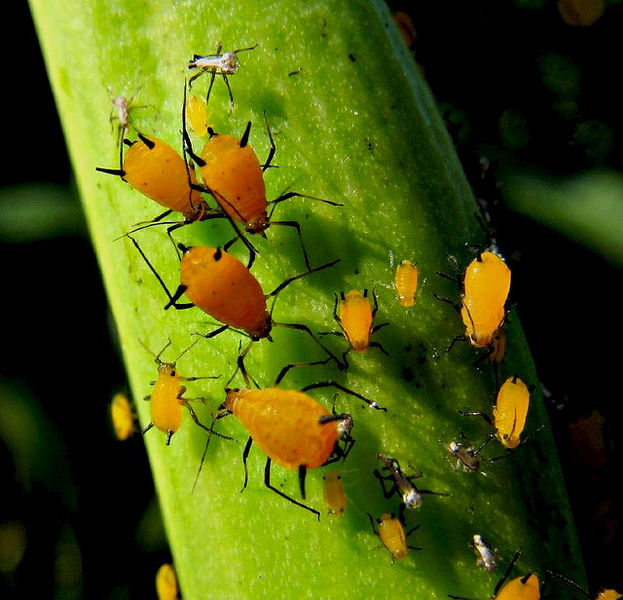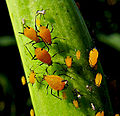

Another member of the milkweed zoo, the milkweed [or oleander] aphid protects itself with cardiac glycosides, just like the monarch, and several beetles and true bugs. Botanists put milkweed and oleander in the same family now, based on DNA evidence.
"The oleander aphid (Aphis nerii Boyer de Fonscolombe) is a distinct bright yellow aphid with black legs, antennae, cauda (tail-like appendage), and cornicles (tubes that extend from the abdomen). It is thought to originate in the Mediterranean and probably spread as oleanders were introduced around the world. The aphid is now found in tropical and temperate zones worldwide.
When the oleander aphid finds its preferred hosts, plants in the Asclepiadaceae and Apocynaceae, the population explodes. All of the aphids are females; they reproduce by parthenogenesis (clones of the mother) and they bear live young (nymphs). If conditions become too crowded on a plant or the plant declines in health, some of the aphids develop wings and will colonize new plants.
The aphids' bright coloring is a warning to predators. The aphids sequester the cardenolides (cardiac glycosides) produced by the milkweeds and dogbanes. When a predator disturbs the aphids, they exude the cardenolides in a waxy compound through the cornicles. Predators usually back away and clean the defensive compound from their mouthparts.
The amount of cardenolides present in milkweeds and dogbanes varies with the species, the age of the plant, and the season. Aphids that feed on plants with low amounts of the glycosides are more likely to fall prey to generalist predators like spiders, ladybug larvae, and aphid lions (lacewing larvae).
Generalist predators that survive eating the oleander aphids suffer the effects of the cardenolides. Fewer aphid lions survive to become lacewings and reproduce. Ladybugs develop deformed wings. And spiders weave strange disrupted webs.
The Bug Guide has posted a great photograph of oleander aphids taken by Lynette Schimming. To view these aphids on a milkweed, click on the link:"
http://creativecommons.org/licenses/by/2.0/deed.en
Click on a date/time to view the file as it appeared at that time.
| Date/Time | Thumbnail | Dimensions | User | Comment | |
|---|---|---|---|---|---|
| current | 05:11, 10 December 2010 |  |
640 × 616 (124 KB) | Wiedman (Talk | contribs) | Another member of the milkweed zoo, the milkweed [or oleander] aphid protects itself with cardiac glycosides, just like the monarch, and several beetles and true bugs. Botanists put milkweed and oleander in the same family now, based on DNA evidence. ==== |
There are no pages that link to this file.